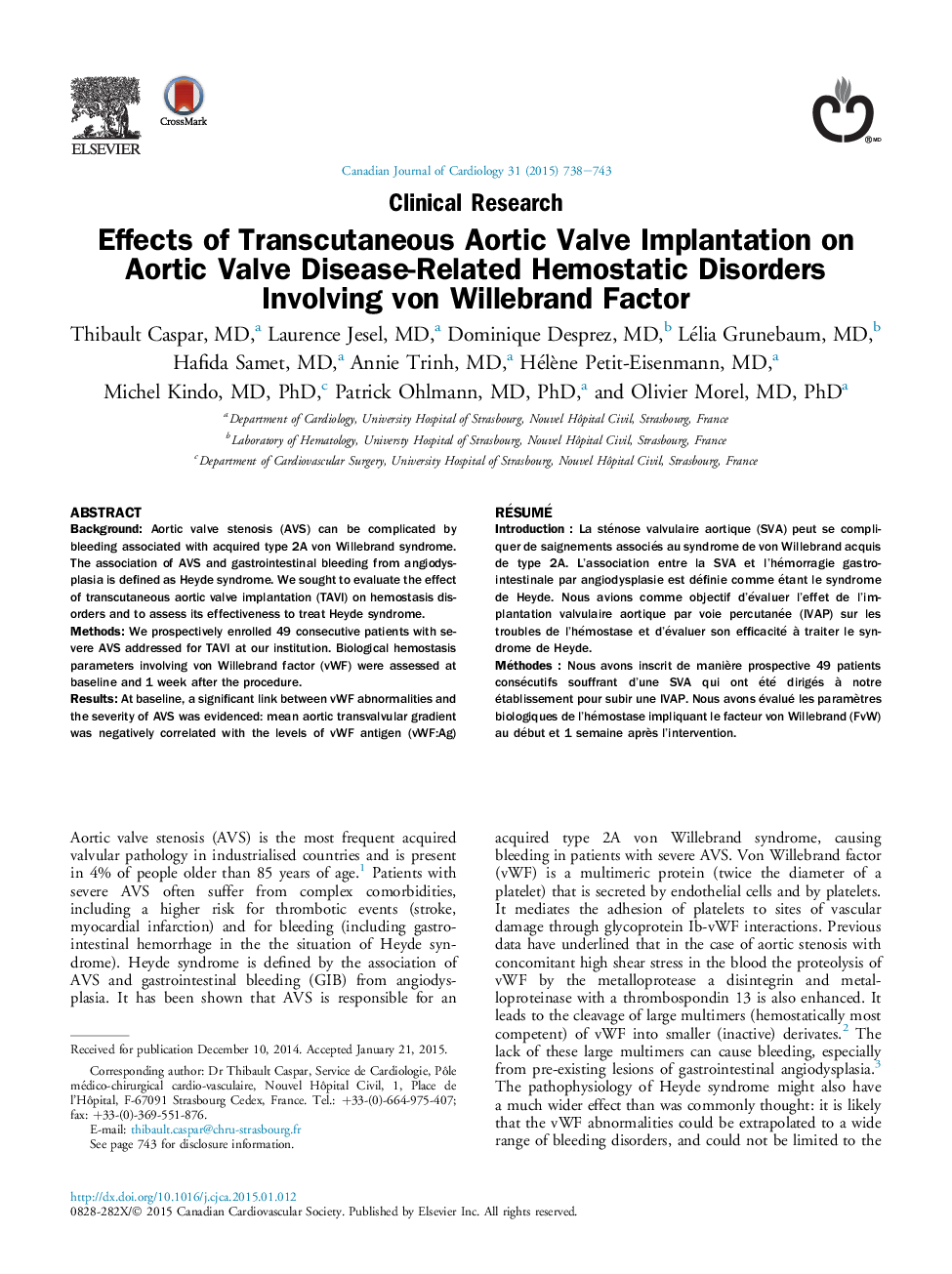| کد مقاله | کد نشریه | سال انتشار | مقاله انگلیسی | نسخه تمام متن |
|---|---|---|---|---|
| 2730708 | 1566497 | 2015 | 6 صفحه PDF | دانلود رایگان |
BackgroundAortic valve stenosis (AVS) can be complicated by bleeding associated with acquired type 2A von Willebrand syndrome. The association of AVS and gastrointestinal bleeding from angiodysplasia is defined as Heyde syndrome. We sought to evaluate the effect of transcutaneous aortic valve implantation (TAVI) on hemostasis disorders and to assess its effectiveness to treat Heyde syndrome.MethodsWe prospectively enrolled 49 consecutive patients with severe AVS addressed for TAVI at our institution. Biological hemostasis parameters involving von Willebrand factor (vWF) were assessed at baseline and 1 week after the procedure.ResultsAt baseline, a significant link between vWF abnormalities and the severity of AVS was evidenced: mean aortic transvalvular gradient was negatively correlated with the levels of vWF antigen (vWF:Ag) (r = −0.29; P < 0.05), vWF ristocetin cofactor activity (r = −0.402; P = 0.006), and vWF collagen-binding activity (vWF:CB; r = −0.441; P = 0.005). One week after the procedure, a significant increase of vWF:Ag, vWF ristocetin cofactor activity, and vWF:CB was evidenced in the whole cohort (respectively, 3.32 vs 2.29 IU/mL, P < 0.001; 2.98 vs 1.86 IU/mL, P < 0.001; and 3.16 vs 2.16 IU/mL, P < 0.001). Patients with pre-TAVI vWF abnormalities consistent with a type 2A vWF syndrome (ratio vWF:CB/vWF:Ag < 0.7) preferentially improved their vWF function with respect to patients with a normal ratio (relative increase of vWF:CB of 63.8% vs 3.5%).ConclusionsHemostasis parameters involving vWF are improved after TAVI, especially in patients with pre-existing abnormalities consistent with acquired type 2A von Willebrand syndrome.
RésuméIntroductionLa sténose valvulaire aortique (SVA) peut se compliquer de saignements associés au syndrome de von Willebrand acquis de type 2A. L'association entre la SVA et l'hémorragie gastro-intestinale par angiodysplasie est définie comme étant le syndrome de Heyde. Nous avions comme objectif d’évaluer l'effet de l'implantation valvulaire aortique par voie percutanée (IVAP) sur les troubles de l'hémostase et d’évaluer son efficacité à traiter le syndrome de Heyde.MéthodesNous avons inscrit de manière prospective 49 patients consécutifs souffrant d'une SVA qui ont été dirigés à notre établissement pour subir une IVAP. Nous avons évalué les paramètres biologiques de l'hémostase impliquant le facteur von Willebrand (FvW) au début et 1 semaine après l'intervention.RésultatsAu début, un lien significatif entre les anomalies du FvW et la gravité de la SVA a été mis en évidence : le gradient transvalvulaire moyen corrélait négativement avec les concentrations d'antigène du FvW (FvW : Ag; r = −0,29; P < 0,05), l'activité du cofacteur de la ristocétine du FvW (r = −0,402; P = 0,006) et l'activité de liaison au collagène du FvW (FvW : LC; r = −0,441; P = 0,005). Une semaine après l'intervention, une augmentation significative du FvW : Ag, de l'activité du cofacteur de la ristocétine du FvW et du FvW : LC a été mise en évidence dans la cohorte entière (respectivement, 3,32 vs 2,29 UI/ml, P < 0,001; 2,98 vs 1,86 UI/ml, P < 0,001; et 3,16 vs 2,16 UI/ml, P < 0,001). Les patients ayant des anomalies du FvW avant l’IVAP qui correspondent au syndrome de vW de type 2A (ratio FvW : LC/FvW : Ag < 0,7) ont particulièrement amélioré leur fonctionnement du FvW par rapport aux patients ayant un ratio normal (augmentation relative du FvW : LC de 63,8 % vs 3,5 %).ConclusionsLes paramètres de l'hémostase impliquant le FvW s'améliorent après l’IVAP, particulièrement chez les patients ayant des anomalies préexistantes qui correspondent au syndrome de von Willebrand acquis de type 2.
Journal: Canadian Journal of Cardiology - Volume 31, Issue 6, June 2015, Pages 738–743
